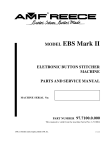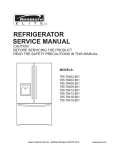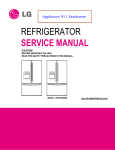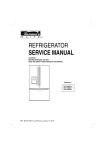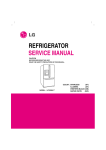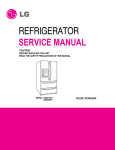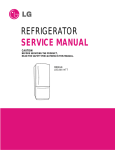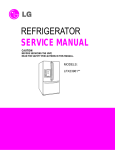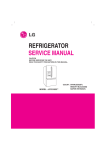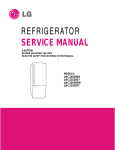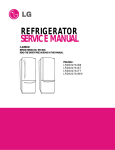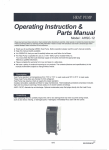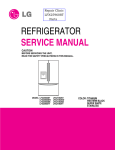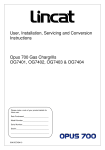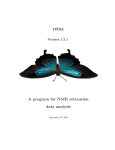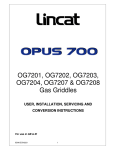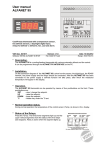Download LG Refrig
Transcript
REFRIGERATOR SERVICE MANUAL CAUTION BEFORE SERVICING THE UNIT, READ THE SAFETY PRECAUTIONS IN THIS MANUAL. MODELS: LFX23961SW /01 LFX23961ST /01 LFX23961SB /01 CONTENTS SAFETY PRECAUTIONS ................................................................................................................................... 2 1. SPECIFICATIONS ........................................................................................................................................... 3 2. PARTS IDENTIFICATION ............................................................................................................................... 4 3. DISASSEMBLY ............................................................................................................................................... 5 4. ADJUSTMENT ................................................................................................................................................ 17 5. CIRCUIT DIAGRAM ........................................................................................................................................ 19 6. TROUBLESHOOTING .................................................................................................................................... 20 7. OPERATION PRINCIPLE AND REPAIR METHOD OF ICEMAKER ............................................................. 25 8. DESCRIPTION OF FUNCTION & CIRCUIT OF MICOM ................................................................................ 28 9. EXPLODED VIEW .......................................................................................................................................... 43 SAFETY PRECAUTIONS Please read the following instructions before servicing your refrigerator. 7.Before tilting the refrigerator,remove all materials from On or in the refrigerator. 1.Check the refrigerator for current leakage. 2.To preven telectric shock,unplug before servicing. 8.When servicing the evaporator,wear gloves to prevent Injuries from the sharp evaporator fins. 3.Always check line voltage and amperage. 4.Use standard electrical components. 9.Service on the refrigerator should be performed by a Qualified technician.Sealed system repair must be Performed by a CFC certified technician. 5.Don't touch metal products in the freezer with wet Hands.This may cause frost bite. 6.Prevent water from spiling on to electric elements or the Machine parts. -2- SPECIFICATIONS Color Dimensions MODELS 1. SPECIFICATIONS LFX23961SW LFX23961ST LFX23961SB Super White Net Weight 124kg Capacity 23 cuft Refrigerant R134a (120gr) Climate class Temperate (N) Rated Rating 115V~ / 60Hz GENERAL FEATURES Cooling System MICOM control Full Automatic Defrosting System Heater Defrost Insulation Cyclo, Pentane Compressor LD72LACM PTC Starting Type Evaporator Fin Tube Type Condenser Wire Condenser Polyol Ester (POE) 310± 10cc Drier MOLECULAR SIEVE XH-7 Capillary Tube ID Ø0.75 First Defrost 4 Hours Defrost Cycle 7 - 40 Hours Desfrosting Device Heater, Sheath Anti-freezing Heater Water Tank Heater Case Material REFRIGERATOR Door Material Black Fan Cooling Temperature Control Lubricanting Oil FREEZER Stainless 892 (W) x 925 (D) x 1860 (H) mm Embo (normal) PCM Handle Type Stainless Vista Display Graphic ICE PLUS Basket, Quantity 1 left + 3 right Ice Tray & Bank AUTO ICE MAKER Lamp Yes (2) 40W/Blue Shelf 4 Fix Tray meat Yes Egg Bank No Basket, Quantity No Lamp Yes (1) 40W/Blue Tray Drawer F/U Yes (Full Width) Tray Drawer F/L Yes (Plastic) Shelf No -3- VCM 2. PARTS IDENTIFICATION I A J B K C E D E F L M G N H O P Use this page to become more familiar with the parts and features. Page references are included for your convenience. NOTE: This guide covers several dierent models. The refrigerator you have purchased may have some or all of the items listed below. The locations of the features shown below may not match your model. Ice Bucket A Refrigerator Light J Dairy Bin B Ice Room K Refrigerator Shelves C Egg Box L Freezer Light D Snack Pan M Turbo Motor E Modular Door Bins N Glide out Drawer F Water Tank Cover G Crisper Ice Room Door O Durabase P Divider *On some models H Ice Bin I Filter (Inside) -4- 3. DISASSEMBLY 3-1 DOORS 1. Removing Refrigerator Door NOTE: Handle appearance may vary. IMPORTANT: Before you begin, turn the refrigerator OFF and unplug it. Remove food and any bins from doors. Left Door Loosen the screws and remove the cove on back side (see figure A). Disconnect water supply tube by pushing back on the disconnect ring (3). Loosen the cover screw (1). Disconnect door switch wire (2). Pull out the tube (4). CAUTION: If a tube end is deformed or worn out, cut the damaged portion away. Disconnect wire harness (5). Remove the ground screw (6). Loosen screws (7) and lift off the top hinge (8). Place the door on a non-scratching surface with the inside up. CAUTION: When removing top hinge, be careful that the door does not fall forward. Right Door Loosen the cover screw (1). Disconnect door switch wire (2). Loosen screws (7) and lift off the top hinge (8). Place the door on a non-scratching surface with the inside up. (1) (1) (2) (6) (4) (7) (5) (7) (2) (8) (8) Figure A 3 -5- 2. Replacing Refrigerator Door Right Door Lower the door onto the middle hinge pin (9). Make sure the door is aligned with the cabinet. Replace the top hinge (8) installing hinge screws (7) to secure it. Make sure the gasket on the door is flush against the cabinet and is not folded. Support the door on the handle side while securing hinge. Make sure the door is straight and the gap between the doors is even. Connect the door switch wire (2). Tighten the cover screw (1). Left Door Lower the door onto the middle hinge pin (10). Make sure the door is aligned with the cabinet. Replace the top hinge (8) installing hinge screws (7) to secure it. Make sure the gasket on the door is flush against the cabinet and is not folded. Support the door on the handle side while tightening. And make sure the door is straight and the gap between the doors is even. Insert the water supply tube (4) into the connector tube until you see only one scale mark. (Fully insert the tube over 5/8” (15 mm)). Install the ground screw (6) and connect the wire harness (5). Connect the door switch wire (2). Tighten the cover screw (1). Caution 10 Connecting tube color • Blue to Blue • White to White 1. 9 -6- 3-2 REMOVING REFRIGERATOR HANDLE 3-4 DOOR GASKET REMOVAL 1.Removing Refrigerator Handle 1. Remove door frame cover Starting at top of cover and working down, snap cover out and away from door. • Loosen the set screws with the 3/32” Allen wrench and remove the handle. NOTE: If the handle mounting fasteners need to be tightened or removed, use a 1/4” Allen wrench. Frame Cover Handle Mounting Fasteners Set Screw 2. Remove gasket bracket clips There are two clips on each door. Start bracket removal near one of the middle clips. 1) Pull gasket back to expose gasket bracket clip and door frame. 2) Insert a flat tip screwdriver into seam between gasket bracket and door frame and pry back until clips snap out. 3) Continue prying back along seam until all clips snap out. Allen Wrench Door Frame 3-3 REMOVING FREEZER HANDLE 2.Removing Freezer Drawer Handle Gasket Bracket Clip Flat Tip Screwdriver • Loosen the set screws located on the lower side of the handle with the 3/32 ” Allen wrench and remove the handle. NOTE: If the handle mounting fasteners need to be tightened or removed, use a 1/4” Allen wrench. Gasket Bracket 3. Remove gasket Pull gasket free from gasket channel on the three remaining sides of door. -7- 3-5 DOOR GASKET REPLACEMENT 1. Insert gasket bracket clips 1) Insert gasket bracket edge beneath door frame edge. 2) Turn upper gasket bracket spring so that the spring ends are in the door channel. 3) Push in clip until you hear it snap securely into place. 2) Press gasket into channels on the three remaining sides of door. Gasket Bracket Clip Spring Door Frame Correct Incorrect 3) Replace door frame cover Starting at top of cover and working down, snap cover back into door. 4) Push in remaining clip until you hear it snap securely into place. Note: Make sure that no part of gasket bracket edge protrudes from beneath door frame edge. 2. Insert gasket into channel 1) Snap gasket assembly into the door bracket. <Inserting the Gasket Assembly into the Bracket Door> 3-6 DOOR ALIGNMENT If fridge door are uneven, • Use the wrench to adjust the bolt in the door hinge to adjust the height.(CCW to raise or CW to lower the height.) Correct Incorrect -8- 3-7 FAN AND FAN MOTOR(EVAPORATOR) 3-8 DEFROST CONTROL ASSEMBLY 1. Remove the freezer shelf. (If your refrigerator has an icemaker, remove the icemaker first) 2. Remove the plastic guide for slides on left side by unscrewing phillips head screws. 3. Remove the grille by pulling the grille fan forward. 4. Remove the Fan Motor assembly by loosening 2 screws and disassembling the shroud. 5. Pull out the fan and separate the Fan Motor and Bracket. Defrost Control assembly consists of Defrost Sensor and 2 FUSE—M. The Defrost Sensor works to defrost automatically. It is attached to the metal side of the Evaporator and senses its temperature. At 72°C, it turns the Defrost Heater off. Fuse-M is a safety device for preventing over-heating of the Heater when defrosting. 1. Pull out the grille assembly. 2. Separate the connector with the Defrost Control assembly and replace the Defrost Control assembly FAN MOTOR GRILLE ASSEMBLY BRACKET MOTOR FAN GRILLE * Ice Fan Scroll Assembly Replacement 1) Remove the plastic guide for slides on left side by unscrewing phillips head screws. 2) Pull the grille forward as shown in the second picture. 3) Disconnect wire harness of the grille 4) Remove the scroll assembly by loosening 3 screws (1) (2) (3) (4) -9- DEFROST-CONTROL ASSEMBLY 3-9 LAMP 3-10 MULTI DUCT 1. Remove the upper and lower Caps by using a flat screwdriver, and remove 2 screws. 2. Disconnect the lead wire on the bottom position. 3-9-1 Refrigerator Compartment Lamp 1. Unplug Refrigerator, or disconnect power at the circuit breaker. 2. If necessary, remove top shelf or shelves. 3. Using a flat instrument, gently pry the cover loose in the front as shown. Rotate downward to remove rear tabs.4. Make sure the bulbs are cool to the touch. Turn bulbs counterclockwise to remove. 5. Assemble in reverse order by snapping the Lamp Cover in, engaging the rear tabs followed by the front tabs. (Max. 40 W-2EA) 3-11 MAIN PWB 1) Loosen the 3 screws on the PWB cover. 2) Remove the PWB cover 3-9-2 Freezer Compartment Lamp 1. Unplug refrigerator power cord form outlet. 2. Gently pry the lamp cover loose in the back as shown. Rotate forward to remove the front tabs. 3. Make sure the bulb is cool to the touch. Turn the bulb counterclockwise to remove. 4. Replace with a new 40-watt appliance bulb. 5. Insert tabs on front of cover into slots in freezer ceiling. Push cover up to snap back into place. 3) Disconnect wire harness and replace the main PWB in 1) Pull out the darin 2) Grasp the lower 3) Hold the inner side part of the dispenser of cover dispenser firmly ,pull it out. with both hands at the handle side to pull it out forward. - 10 - 3-15 WATER BUTTON ASSMEBLY 1) Remove screws. 2) Grasp the Button assembly and lift up. Button Lever 4) If nozzle is interfered with button, push and pull out the bottom of button 5) Remove the connected part of lead wire. CAUTION: When replacing the dispenser cover in the reverse order of removal, be careful that the lead wire does not come out and the water tube is not pinched by the dispenser. 3-16 DUCT DOOR REPLACEMENT 1) Pull up and out on the dispenser cover to remove. 2) Disconnect the wire harness. 3) Remove the funnel 3-12 DISPLAY PCB 4) Replace in reverse order. As shown below, remove 1 case PCB fixing screw Remove the display PCB fixing screw. Case, PCB Display PCB 3-13 ICE BUTTON ASSEMBLY 1) Remove the screw fixing the button lever. 2) Push the spring from the hanging hook to remove it. 3) Apply some pressure to the rib in direction and lift the button in direction. 3-17 ICE CORNER DOOR REPLACEMENT 1) Loosen the front screw as shown in the picture. 2) Lift up the hinge with one hand. 3) Pull out the Ice Corner Door with the other hand. 1 2 Hinge Button Lever 3-14 FUNNEL REPLACEMENT Pull down and forward - 11 - 3-18 ICEMAKER ASSEMBLY 1) Loosen two screws as shown in the first picture. 2) Disconnect the wire harness & ground screw replace theIcemaker assembly in the reverse order of removal. 3) It separates a ground connection screw. 3-19 AUGER MOTOR COVER 1) After removing the icemaker remove the (5) stainless screws holding the auger motor cover, shown in the picutres below. 2) Grip the bottom of motor cover assembly and pull out it. 3) Disconnect wire harness of motor cover assembly. There is a auger motor on the back, as shown in the picture. Auger Motor - 12 - 3-20 HOW TO REMOVE A DOOR ICE BIN 3-21 HOW TO INSERT A DOOR ICE BIN 1) Grip the handles, as shown in the picture. 1) Insert the Ice Bin, slightly tilting it to avoid touching the Icemaker. (especially, ice maker lever) 1 2 2) Lift the lower part slightly. Insert the ice bucket carefully avoid contacing the automatic shut off arm. 3) Take the Ice Bin out slowly. - 13 - 3-22 PULL OUT DRAWER (a) HOW TO INSTALL PULL OUT DRAWER IMPORTANT: To avoid possible injury, product or property damage, you will need two people to perform the following instructions. • Align the top holes of the rail cover with the top holes of the door supports to assemble the rail cover. • With both hands, hold the center of the bar and pull it out to let both rails out to full extension simultaneously. Fig. 1 Fig. 5 • Verify the hole’s assembly • Hook door supports into rail tabs. Fig. 2 Door Supports Fig. 6 Rail tabes • Lower door into final position and tighten the screws. Fig. 3 Fig. 7 Screws • With the rails pulled out to full extension, insert the durabase in the rail assembly. Fig. 8 Durabase • Make sure you have a right rail cover for each side. Right Rail cover Left Rail cover Fig. 4 W A R N I N G : To prevent accidental child and pet entrapment or suffocation risk. DO NOT allow them to play inside of drawer. W A R N I N G : DO NOT step or sit down on Freezer Door. - 14 - (b) HOW TO REMOVE PULL OUT DRAWER IMPORTANT: To avoid possible injury, product or property damage, you will need two people to perform the following instructions. • Pull the drawer open to full lower extension. Remove durabase by lifting it from rail system. Fig. 9 Durabase When removing drawer door, do not hold it C A U T I O N : by the handle. Door could fall down and you may be injured grasp door with both hands as pictured below When removing. C A U T I O N : When laying down the drawer, be careful not to damage the floor or hurt your feet with the sharp edges on hinge side. • With both hands, hold both sides of the door and pull it up to separate it from the rails. Fig. 13 • Press both hangers with yours thumbs to lift it up. Fig. 10 Fig. 14 Door supports Rail tabes • Separate the left and right rail cover Fig. 11 • Push rails back into drawe cavity. With both hands, hold the center of the bar and push it in so that both rails go back simultaneously. Fig. 15 • Remove the screws of the rail on both sides. Fig. 12 Fig. 16 screw - 15 - 3-24 PULL OUT DRAWER 3-23 FAN AND FAN MOTOR DISASSEMBLY METHOD 1. To remove, lift basket up and pull out straight out. 1) Using a short screwdriver, loosen one SCREW in DRAIN PIPE ASSEMBLY and one connected to the MOTOR COVER. MOTOR COVER 1 2 R 2) Pull and separate the FAN ASSEMBLY and MOTOR turning counterclockwise based on the MOTOR SHAFT. FAN ASSEMBLY 2. To Install, pull both rails out to full extension. Hook the basket supports into the rail tabs and push to the back of compartment. MOTOR R The assembly is in the reverse order of the disassembly and take special care for the following details. 1. Be careful not to bend the tube during assembly. 2. Press the WATER DISPENSER button until water pours out and check for leakage in the CONNECTOR TUBE (It differs by the water pressure but usually takes about 2 minutes until water pours out.) - 16 - 4. ADJUSTMENT 4-1 COMPRESSOR 4-2-3 PTC-Applied Circuit Diagram 4-1-1 Role Starting Method for the Motor The compressor intakes low temperature and low pressure gas from the evaporator of the refrigerator and compresses this gas to high-temperature and high-pressure gas. It then delivers the gas to the condenser. OVERLOAD PROTECTOR N 4-1-2 Composition The compressor includes overload protection. The PTC starter and OLP (overload protector) are attached to the outside of the compressor. Since the compressor is manufactured to tolerances of 1 micron and is hermetically sealed in a dust and moisture-free environment, use extreme caution when performing repairs. 4-2 PTC-STARTER 4-2-1 Composition of PTC-Starter (1) PTC (Positive Temperature Coefficient) is a no-contact semiconductor starting device which uses ceramic material consisting of BaTiO3. (2) The higher the temperature is, the higher the resistance value. These features are used as a starting device for the Motor. 4-2-2 Role of PTC-Starter (1) The PTC is attached to the Sealed Compressor and is used for starting the Compressor Motor. (2) The compressor is a single-phase induction motor. The starting operation, the PTC allows current flow to both the start winding and main winding. 3 2 5 6 LFX25980** 2 3 6 5 C PTC 2 S COMPRESSOR MOTOR M M S L1 PTC STARTER 4-1-3 Note for Usage (1) Be careful not to allow over-voltage and over-current. (2) If compressor is dropped or handled carelessly, poor operation and noise may result. (3) Use proper electric components appropriate to the Particular Compressor in your product. (4) Keep Compressor dry. If the Compressor gets wet (in the rain or a damp environment) and rust forms in the pin of the Hermetic Terminal, poor operation and contact may result. (5) When replacing the Compressor, be careful that dust, humidity, and soldering flux don’t contaminate the inside of the compressor. Dust, humidity, and solder flux contaminate the cylinder and may cause noise, improper operation or even cause it to lock up. LFX21980** SEALED TERMINAL Resistance Starter Capacitor Running 4-2-4 Motor Restarting and PTC Cooling (1) It requires approximately 5 minutes for the pressure to equalize before the compressor can restart. (2) The PTC device generates heat during operation. Therefore, it must be allowed to cool before the compressor can restart. 4-2-5 Relation of PTC-Starter and OLP (1) If the compressor attempts to restart before the PTC device is cooled, the PTC device will allow current to flow only to the main winding. (2) The OLP will open because of the over current condition. This same process will continue (3 to 5 times) when the compressor attempts to restart until the PTC device has cooled. The correct OLP must be properly attached to prevent damage to the compressor. Parts may appear physically identical but could have different electrical ratings. Replace parts by part number and model number. Use only approved substitute parts. 4-2-6 Note for Using the PTC-Starter (1) Be careful not to allow over-voltage and over-current. (2) Do not drop or handle carelessly. (3) Keep away from any liquid. If liquid such as oil or water enters the PTC, PTC materials may fail due to breakdown of their insulating capabilities. (4) If the exterior of the PTC is damaged, the resistance value may be altered. This can cause damage to the compressor and result in a no-start or hard-to-start condition. (5) Always use the PTC designed for the compressor and make sure it is properly attached to the compressor. Parts may appear physically identical but could have different electrical ratings. Replace parts by part number and model number. Use only approved substitute parts. - 17 - 4-3 OLP (OVERLOAD PROTECTOR) 4-4 TO REMOVE THE COVER PTC 4-3-1 Definition of OLP (1) OLP (OVERLOAD PROTECTOR) is attached to the Compressor and protects the Motor by opening the circuit to the Motor if the temperature rises and activating the bimetal spring in the OLP. (2) When high current flows to the Compressor motor, the Bimetal works by heating the heater inside the OLP, and the OLP protects the Motor by cutting off the current flowing to the Compressor Motor. 4-3-2 Role of the OLP (1) The OLP is attached to the Sealed Compressor used for the Refrigerator. It prevents the Motor Coil from being started in the Compressor. (2) For normal operation of the OLP, do not turn the Adjust Screw of the OLP in any way. (2) Disconnect two housing upper side of comp connected in. (OVERLOAD PROTECTOR cross section) 12345678 330 FBYY Electrical characteristics part number -S1 BOX98 Customer part number Lot code/ date code Physical termination part number (1) Remove the Cover Back M/C. Part No. Name (3) Loosen two screws on comp base. Base, phenolic (UL 94 V-0 rated) Movable arm support, plated steel Stationary contact support, plated steel Heater support, plated steel Heater, resistance alloy Disc, thermostatic alloy Movable arm, spring temper copper alloy Contact, movable, silver on copper Contact, stationary, silver on copper Slug, plated steel Cover, polyester (UL 94 V -0 rated) Pin connector, plated copper alloy (To engage 2.33/2.66 mm dia. pin) Quick-connect terminal, brass, conforms to UL 310, MEMA DC-2, DIN 46344 1 3 2 Figure 19 (4) Use a L-shaped flap tool to pry off the cover. (5) Assembly in reverse order of disassembly. - 18 - 5. CIRCUIT DIAGRAM DUCT - HTR F - LAMP 6 C S M P.T.C. COMP’ ACCESSORIES c ICE MAKER POWER S/W b N ICE MAKER KIT a YL 1 2 BL 3 4 BO 5 6 7 ICE VALVE d d PILOT VALVE 1 2 3 4 5 6 WH/BK BO BN RD BL BL ICING - SENSOR BL/WH CON2 WH/RD 1 BL/WH 2 CON1 PWB ASSEMBLY, LAMP BK: BLACK YL: YELLOW SB: SKY BLUE BN: BROWN WH/RD BL/WH 1 2 3 CON103 CON101 CON2 *P.T.C. OPTION LD, MQ COMP’ 1 2 M AUGER MOTOR SOLENOID CUBE WATER/PILOT VALVE SOLENOID DISPENSER *COMP’ ACCESSORIES 3 4 5 4 6 3 6 2 5 CON1 PWB ASSEMBLY, LAMP GN: GREEN PK: PINK BO: BRIGHT ORANGE PR: PURPLE GY: GRAY WH: WHITE BL: BLUE RD: RED - 19 - CR BL f DISPENSER LED e PWB ASSEMBLY, S/W EG COMP’ 2 WH/RD BL/WH RD PR BK SB CON102 PWB ASSEMBLY, DISPLAY CON1 *PLUG TYPE, CAPACITOR PART, P.T.C. AND COMP’ ACCESSORIES ON CIRCUIT DIAGRAM ARE SUBJECT TO CHANGE IN DIFFERENT LOCALITIES AND MODEL TYPE. 1 2 3 e ICE LEVER S/W RT - SENSOR 6 5 4 3 2 1 GN/YL WH/RD WATER PIPE - HTR 1 2 3 4 5 6 7 8 9 10 11 12 F - SENSOR WH/BK BO BN RD BN BN CON5 BK 1 WH 2 NEUTRAL R - SENSOR f PLUG TYPE LIVE CON4 CON6 CON2 L D - SENSOR DOOR DUCT - HTR 5 1 2 3 4 4 3 PWB ASSEMBLY, DISPLAY F - DOOR S/W BK OLP OLP CON1 STEPPING MOTOR a 1 2 3 4 5 6 7 8 COMP’ 2 BL BK YL RD SB SB BO BO WH WH BL BL DISPENSER LED 1 2 3 4 5 6 7 8 9 10 11 12 b PK CON3 CAPACITOR CR PART CS c RD BL YL BN FUSE - M R - DOOR S/W 13 WH/RD 12 BL/WH 11 SB 10 YL 9 WH 8 PK 7 WH/BK 6 GY 5 BL 4 BO 3 RD 2 BN 1 BK SHEAT - HTR GY GY CON4 WH BO RD BL YL BN SB PK d C - FAN BL WH YL GY THERMOSTAT R - LAMPS ICING F - FAN SB 11 10 WH 9 8 WH/BK 7 GY 6 BL 5 BO 4 RD 3 BN 2 BK 1 GY SB BN PR PK BO BK FD - HTR F - FAN WATER LEVER S/W OUT PLATE - HTR WH BK PR RD BL BN SB BO ICE MAKER POWER S/W DETECTION BL BO BL d BARRIER - HTR 1 2 3 4 5 6 7 8 9 10 11 1 2 3 4 5 6 7 8 9 10 11 12 FRONT - HTR N PTC L COMBO KIT (PTC + OLP) GN/YL: GREEN/YELLOW BL/WH: BLUE/WHITE BK/WH: BLACK/WHITE RD/WH: RED/WHITE 6. TROUBLESHOOTING 6-1 COMPRESSOR AND ELECTRIC COMPONENTS 1 Power Source. YES Remove PTC-Starter from Compressor and measure voltage between Terminal C of Compressor and Terminal 5 or 6 of PTC. (Rated Voltage –10%)? No Voltage. OLP disconnected? 2 YES Reconnect. NO 5 Check connection condition. Replace OLP. Applied voltage isn’t in acceptable range. (115V –10%) Advise customer that power supply needs to be checked by an electrician. The range of resistance is between 1~50½(ok) Check resistance of Motor Compressor. Check resistance between M-C, S-C and M-S in Motor Compressor. 3 Check resistance of PTC-Starter. Check resistance of two terminals in PTC-Starter. At normal temperature 6.8? +20: OK 4 Check OLP. Check resistance of two terminals in OLP. If power conducts: OK If not: NG 5 Check starting state. Check the power supply under load. (Compressor attempting to re-start after being off for 5 minutes). 2 5 Open or short Replace Compressor. Supply voltage rating with –10%. YES 3 Did compressor start? 4 YES NO NO - 20 - 3 5 Compressor is OK Replace the compressor 1 6-2 OTHER ELECTRICAL COMPONENTS • Not cooling at all Compressor doesn’t run. Check for open short or incorrect resistance readings in the following components Cause a. Starting devices Short, open, or broken. b. OLP Poor contact or shorted. c. Compressor coil Coil open or shorted. d. Wiring harness Poor contact or shorted. Replace indicated component. • Poor cooling performance Compressor runs poorly. Fan motor doesn’t run. Check starting voltage. Low voltage. Advise customer that the Power supply needs to be checked by an electrician. Check voltage at starting devices. Poor or broken or open contact. Replace indicated component. Check current flowing in sub-coil of Compressor. Shorted. Check rating of OLP. Lack of capacity. Check wiring circuit. Wire is open or shorted. Coil is shorted or open. Check Fan Motor. Heavy frost buildup on EVAPORATOR. Replace indicated component. Check current flow in the following components: Sensor Fuse-M Check current flow in the Defrost Heater. - 21 - Open. Replace indicated component. Open. Replace Defrost Heater. 6-3 SERVICE DIAGNOSIS CHART COMPLAINT POINTS TO BE CHECKED No Cooling. •Is the power cord unplugged from the outlet? • Check if the power switch is set to OFF. • Check if the fuse of the power switch is shorted. • Measure the voltage of the power outlet. • Plug into the outlet. • Set the switch to ON. • Replace the fuse. • If the voltage is low, correct the wiring. Cools poorly. • Check if the unit is placed too close to the wall. • Check if the unit is placed too close to the stove, gas cooker, or in direct sunlight. • Is the ambient temperature too high or the room door closed? • Check if food put in the refrigerator is hot. • Did you open the door of the unit too often or check if the door is sealed properly? • Check if the Control is set to Warm position. • Place the unit about 4 inches (10 cm) from the wall. • Place the unit away from these heat sources. Food in the Refrigerator is frozen. • Is food placed in the cooling air outlet? • Check if the control is set to colder position. • Is the ambient temperature below 41°F(5°C)? • Place foods in the high-temperature section. (front part) • Set the control to Recommended position. • Set the control to Warm position. Condensation or ice forms inside the unit. • Is liquid food sealed? • Check if food put in the refrigerator is hot. • Did you open the door of the unit too often or check if the door is sealed properly? • Seal liquid foods with wrap. • Put in foods after they have cooled down. • Don’t open the door too often and close it firmly. Condensation forms in the Exterior Case. • Check if the ambient temperature and humidity of the surrounding air are high. • Is there a gap in the door gasket? • Wipe moisture with a dry cloth. It will disappear in low temperature and humidity. • Fill up the gap. There is abnormal noise. • Is the unit positioned in a firm and even place? • Adjust the Leveling Screw, and position the refrigerator in a firm place. • Remove the objects. • Are any unnecessary objects placed in the back side of the unit? • Check if the Drip Tray is not firmly fixed. • Check if the cover of the compressor enclosure in the lower front side is taken out. Door does not close well. • Check if the door gasket is dirty with an item like juice. • Is the refrigerator level? Ice and foods smell unpleasant. • Lower the ambient temperature. • Put in foods after they have cooled down. • Don’t open the door too often and close it firmly. • Set the control to Recommended position. • Fix the Drip Tray firmly in the original position. • Place the cover in its original position. • Clean the door gasket. • Is there too much food in the refrigerator? • REMEDY • Check if the inside of the unit is dirty. • Are foods with a strong odor unwrapped? • The unit smells of plastic. • Position in a firm place and level the Leveling Screw. • Make sure food stored in shelves does not prevent the door from closing. • Clean the inside of the unit. • Wrap foods that have a strong odor. • New products smell of plastic, but this will go away after 1-2 weeks. Other possible problems: Check if frost forms in the freezer. Not defrosting Check Components of the defrosting circuit. Check the refrigeration system. The system is faulty. Perform sealed system repair. Check the Thermistor. The operation of the Thermistor is incorrect. - 22 - Replace the Thermistor. 6-4 REFRIGERATION CYCLE • Troubleshooting Chart CAUSE STATE OF THE UNIT STATE OF THE EVAPORATOR TEMPERATURE OF THE COMPRESSOR REMARKS LEAKAGE CLOGGED BY DUST PARTIAL LEAKAGE Freezer compartment and Refrigerator don’t cool normally. Low flowing sound of Refrigerant is heard and frost forms in inlet only. A little higher than ambient temperature. • Refrigerant level is low due ¥ to a leak. • Normal cooling is possible by ¥ restoring the normal amount of ¥refrigerant and repairing the leak. COMPLETE LEAKAGE Freezer compartment and Refrigerator don’t cool normally. Flowing sound of refrigerant is not heard and frost isn’t formed. Equal to ambient temperature. • No discharging of Refrigerant. • Normal cooling is possible by ¥ restoring the normal amount of ¥ refrigerant and repairing the leak. PARTIAL CLOG Freezer compartment and Refrigerator don’t cool normally. Flowing sound of refrigerant is heard and frost forms in inlet only. A little higher than ambient temperature. • Normal discharging of the ¥ refrigerant. • The capillary tube is faulty. WHOLE CLOG Freezer Flowing sound of refrigerant compartment and is not heard and frost isn’t refrigerator don’t cool. Formed. Equal to ambient temperature. • Normal discharging of the ¥ Refrigerant. Cooling operation stops periodically. Flowing sound of refrigerant is not heard and frost melts. Lower than ambient temperature. • Cooling operation restarts ¥ when heating the inlet of the ¥ capillary tube. COMPRESSION Freezer and Refrigerator don’t cool. Low flowing sound of refrigerant is heard and frost forms in inlet only. A little higher than ambient temperature. • Low pressure at high side ¥ of compressor due to low ¥ refrigerant level. NO COMPRESSION No compressing operation. Flowing sound of refrigerant is not heard and there is no frost. Equal to ambient temperature. • No pressure in the high ¥ pressure part of the ¥ compressor. MOISTURE CLOG DEFECTIVE COMPRESSION - 23 - 6-4-1 SEALED SYSTEM DIAGNOSIS “Not Cooling” Complaint All components operating, No airflow problems, Not frosted up as a defrost problem problem has been isolated to sealed system area Frost Pattern? Partial None Equalization Test Equalization Test Very Fast Very Slow Very Slow Very Fast Fast Inefficient Compressor Partial Restriction Complete Restriction Condenser Temperature Cap Tube Sound Hotter than Normal Faint Room Temperature None to Weak Air/Low Side Leak Loss of Change Compressor Not Pumping Trace of Oil Yes No Leak Undercharge (The equalization test is trying to restart a compressor using a start kit after it has been operating.) - 24 - 7. OPERATION PRINCIPLE AND REPAIR METHOD OF ICEMAKER 7-1 OPERATION PRINCIPLE 7-1-1 Operation Principle of IceMaker Power On Start Position Icemaking Mode • Adjusts EJECTOR to Start Position with power on. • Waits until water becomes ICE after starting the icemaking operation. Harvest Mode • Runs MOTOR to drop ice from the tray into the ICE BIN. (During harvest mode, check if the ice bin is full) Park Position Fill • Reaches Start Position • Performs Ice Making Mode after supplying water by operating the SOLENOID in ICE VALVE. • To operate LINE and SERVICE, press and hold the Fill Key for 3 seconds. The icemaker will run through 3 stages: Harvest Fill Icemaking. Test Mode 1. Turning the Icemaker stop switch off (O) stops the ice making function. 2. Setting the Icemaker switch to OFF and then turning it back on will reset the icemaker control. Icemaker Ejector Automatic Shut off Arm Cube Size Indicator Light Power Switch Cube Size Select Button - 25 - 7-2 ICE MAKER FUNCTIONS 7-2-1. Icemaking Mode 1. Icemaking refers to the freezing of supplied water in the ice tray. Complete freezing is assured by measuring the temperature of the Tray with Icemaking SENSOR. 2. Icemaking starts after completion of the water fill operation. 3. The Ice Making function is completed when the sensor reaches 19°F (-7°C), 55 minutes after starting. NOTE :After Icemaker Power is ON, the Icemaker heater will be on for test for 6 sec. 7-2-2. Harvest Mode 1. Harvest (Ice removing) refers to the operation of dropping ices into the ice bin from the tray when icemaking has completed. 2. Harvest mode: (1) The Heater is ON for 30 seconds, then the motor starts. (2) The feeler arm senses the quantity of ice in the ice storage bin while rotating with the EJECTOR. A. Ice storage bin is full : The EJECTOR stops (heater off). B. Ice storage bin is not full : The EJECTOR rotates twice to open for ice. If the EJECTOR does not rotate once within 5 minutes in B mode, separate heater control mode starts operating to prevent the EJECTOR from being constrained. (It is recommended that the user open for ice to return to normal mode.) 7-2-3. Fill/Park Position 1. Once a normal harvest mode has been completed, the water solenoid will be activated. 2. The amount of water is adjusted by pressing the Fill Key repeatedly. This changes the time allowed for fill as illustrated in the table below. Water supply amount TABLE STAGE TIME TO SUPPLY 1 5 sec. INDICATIONS REMARKS The water amount will vary depending 2 on the water control Switch setting, as 5.5 sec. well as the water pressure of the (FIRST STAGE) connected water line. 3 6 sec. - 26 - 7-2-4 Function TEST 1. This is a forced operation for TEST, Service, cleaning, etc. It is operated by pressing and holding the Fill Key for 3 seconds. 2. The test works only in the Icemaking Mode. It cannot be entered from the Harvest or Fill mode. 3. Caution!If the test is performed before water in the icemaker is frozen, the ejector will pass through the water. When the Fill mode begins (Stage 4), unless the water supply has been shut off, added water will overflow into the ice bin. If the control doesn´t operate normally in the TEST mode, check and repair as needed. 4. After water is supplied, the normal CYCLE is followed: icemaking→ Harvest → Park Position → Fill. 5. Five seconds after Stage 5 is completed, the Ice Maker returns to MICOM control. The time needed to supply water resets to the pre- test setting. Diagnosis TABLE STAGE ITEMS INDICATOR REMARKS 1 HEATER Five seconds after heater starts, a heater will go off if the temperature by sensor is higher than 10°C 2 MOTOR Five seconds after heater starts, you can confirm that a motor is moving. 3 HALL IC I Check if Ice Bin is full or not. If Ice bin is full, the motor and heater are off and on stand by until Ice bin is empty. 4 HALL IC II You can confirm HALL IC detection of start position. 5 VALVE 6 Reset Two seconds after detection of start position, you can confirm that valve is on. Five seconds after fifth stage is completed, The icemaker resets to initial status. Return to Status prior to TEST MODE 7-3 DEFECT DIAGNOSIS FUNCTION 7-3-1 ERROR CODES shown on Ice Maker water supply control panel NO DIVISION 1 Normal 2 Icemaking Sensor malfunction INDICATOR CONTENTS Mark time to supply REMARKS None Display switch operates properly Open or short-circuited wire Make sure that the wire on each sensor is connected. - 27 - 8. DESCRIPTION OF FUNCTION & CIRCUIT OF MICOM 8-1 FUNCTION 8-1-1 Display Function 1) When the appliance is plugged in, it is set to 37°F for refrigerator and 0°F for freezer. You can adjust the Refrigerator and the Freezer control temperature by pressing the ADJUST button. 2) When the power initially applied or restored after a power failure, it is set to Control temperature previously. ICE OPTION ICE OPTION 8-1-2. How to Toggle the Display between °F & °C The initial setting is °F and the display temperature mode can be changed from °F to °C or °C to °F by pressing and holding the FREEZER and the REFRIGERATOR keys at the same time for over 5 seconds. 8-1-3 Lock function (dispenser and display button lock) 1) When the refrigerator is first turned on, the buttons are not locked. The display panel shows the padlock unlocked icon. 2) To lock the display, the dispenser, and the control panel, press, and hold the ALARM/LOCK button for 3 seconds. The locked pad lock icon is displayed. 3) The ALARM/LOCK button is the only control feature that remains active in the locked state. The buzzer sound, other control buttons, and the dispenser are deactivated. 4) To release from the locked state, press and hold the ALARM/LOCK button again for 3 seconds. Ex) “LOCK” Ex) “LOCK” Function ON Function OFF 8-1-4 Filter condition display function 1) There is a replacement indicator for the filter cartridge on the dispenser. 2) Water filter needs replacement once six months. 3) Initial month indication is 6 month. Water filter icon turn on to tell you need to replace the filter soon. 4) When filter indicator becomes 0 MONTH “HOLD 3SECS” text will be lighting. 5) After 6 MONTH has passed, “ 0 “ month is shown on display to indicate the filter has to be exchanged. 6) When 6 MONTH has passed or when filter month indication wants to be Reset press 3 seconds the filter button and the graphic light will come off and month display will be 6 (six). In initial Power On / Filter RESET - 28 - Replace indicator light on 8-1-5 Ice Plus selection Please select this function for quick freezing. * Function is repeat Ice Plus Icon whenever pressing Ice Plus button. * Ice Plus function automatically turns off after a fixed time passes. 8-1-6 Dispenser Use Selection 1. Water 1) Water Switch: Hold your cup in the dispenser for a fez seconds with pressing water switch to allow the last drops of water to fall into the cup. 2) Active water button: Place big bowl on the dispenser bottom with pressing active water button to allow the last drop of water to fall into the bowl. 3) When after initially establishing the wqter comes out, the water tank inside fills and until at the time of quiality the hour es caught. 2. Ice 1) You can select cube or crushed ice. 2) Select cube ice or crushed ice by cycling through the selections when pressing the ICE OPTION button. 3) Hold your cup in the dispenser for a few seconds with pressing ice switch to allow the last pieces of ice to fall into the cup. PUSH ACTIVE WATER BUTTON WATER SWITCH ICE SWITCH 8-1-7 Dispenser Light Please select this function for DISPENSER LIGHT MODE. 1. Normal status (LIGHT icon is OFF): When dispenser is operated, DISPENSER LIGHT is ON. 2. ON status (LIGHT icon is ON): DISPENSER LIGHT is on continuously 8-1-8 Control of Freezer Fan Motor 1. Freezer fan motor has high and standard speeds. 2. High speed is used at power-up, for Ice Plus, and when refrigerator is overloaded. Standard speeds is used for general purposes. 3. To improve cooling speed, the RPM of the freezer fan motor change from normal speed to high. 4. High speed (2700RPM) : Initial power on or load corresponding operation, Ice Plus Normal speed (2400RPM) : General working conditions. 5. Fan motor stops when refrigerator open. 8-1-9 Cooling Fan Motor 1. The cooling fan is switched ON and OFF in conjunction with the compressor. 2. The cooling fan runs at a single speed. 3. The Failure sensing mathod is the same as in the fan motor of the freezing fan motor(refer to failure diagnosis function table for failure display). 8-1-10 Icing Fan 1. The Icing Fan is controlled by the the sensor on the top of the ice room. 2. The Failure sensing method is the same as in the fan motor of the freezer (refer to failure diagnosis function table for failure display) - 29 - 8-1-11 Ice Plus 1. The purpose of this function is to intensify the cooling speed of freezer and to increase the amount of ice. 2. Whenever selection switch is pressed, selection/release, the Icon will turn ON or OFF. 3. If there is a power outage and the refrigerator is powered on again, Ice Plus will be canceled. 4. To activate this function, press the Ice Plus key and the Icon will turn ON. This function will remain activated for 24 hrs. The first three hours the compressor and Freezer Fan will be ON. The next 21 hours the freezer will be controlled at the lowest temperature. After 24 hours or if the Ice Plus key is pressed again, the freezer will return to its previous temperature. 5. During the first 3 hours: (1) Compressor and freezer fan (HIGH RPM) run continuously. (2) If a defrost cycle begins during the first 90 minutes of Ice Plus, the Ice Plus cycle will complete its cycle after defrosting has ended. If the defrost cycle begins when Ice Plus has run for more than 90 minutes, Ice Plus will run for two hours after the defrost is completed. (3) If Ice Plus is pressed during defrost, Ice Plus Icon is on but this function will start seven minutes after defrost is completed and it shall operate for three hours. (4) If Ice Plus is selected within seven minutes after compressor has stopped, the compressor (compressor delays seven minutes) shall start after the balance of the delay time. (5) The fan motor in the freezer compartment runs at high speed during Ice Plus. 6. For the rest of the 21 hours, the freezer will be controlled at the lowest temperature. 8-1-12 Alarm for Open Door 1. This feature sounds a buzzer when the freezer or refrigerator door is not closed within 1 minute after it is opened. 2. One minute after the door is opened, the buzzer sounds three times each for 1/2 seconds. These tones repeat every 30 seconds. 3. The alarm is cancelled when the freezer or the refrigerator is closed while the buzzer sounds. Freezer Door Closed or Refrigerator Door Open Closed Closed Open 3 Times 3 Times 3 Times 3 Times Buzzer Within 1 min. 1 min. - 30 - 30 sec 30 sec 30 sec 8-1-13 Defrosting (removing frost) 1. Defrosting starts each time theaccumulated COMPRESSOR running time is between 7:30 and 40 hours. This time is determinated by how often and how long the doors are opened. 2. For initial power on or for restoring power, defrosting starts when the compressor running time reaches 4 hours. 3. Defrosting stops if the sensor temperature reaches 46.4°F(8°C) or more. If the sensor doesn’t reach 46.4°F(8°C) in 1hours, the defrost mode is malfunctioning. (Refer to the defect diagnosis function, 8-1-14.) 4. Defrosting won’t function if its sensor is defective (wires are cut or short circuited) 8-1-14 Defect Diagnosis Function 1. Automatic diagnosis makes servicing the refrigerator easy. 2. When a defect occurs, the buttons will not operate; but the tones. such as ding. will sound. 3. When the defect CODE removes the sign, it returns to normal operation (RESET). 4. The defect CODE shows on the Refrigerator and Freezer Display. ICE OPTION ICE OPTION LED check function: If simultaneously pressing Ice Plus button and Frz Temp. for a second, display LED graphics on. If releasing the button, the LED graphic displays the previous status. Demonstration Mode (Off Mode) 1. Any Door must be opened to enter in this mode 2. To activate this mode press and hold Ice Plus and Refrigerator buttons over 5 seconds. 3. The display will show the word “OFF” 4. In this mode all loads are turn Off (Compressor, Heater, Fans, etc) 5. Lamps and Dispenser Functions works normally. (Even in demonstration mode the refrigerator Lamp automatic off function works normally) 6. To exit Demonstration mode open any Door then press and hold Ice Plus and Refrigerator buttons over 5 seconds (Display return to normal mode). - 31 - ERROR CODE on display panel No. ITEM 1 ERROR CODE CONTENTS FRZ TEMP REF TEMP Failure of Freezer sensor Er FS Cut or short circuit wire. 2 Failure of Refrigerator sensor Er rS Cut or short circuit wire. 3 Failure of defrost sensor Er dS Cut or short circuit wire. 4 Failure of Room Temperature sensor 5 Failure of Icing sensor rt When display check mode: (In LED Er rtEr Check Function) Er IS REMARKS Inspect Connecting wires on each sensor Cut or short circuit wire. Cut or short circuit wire. Snapping of defrost When defrost sensor heater or Temperature doesn't reach 46°F(8°C) fuse, pull-out of within 1 hour after connector (indicated starting defrost minimum 1 hour after failure occurs) Poor motor, hooking to If there is no fan motor wires of fan, contact of sinal for more than structures to fan, 115sec in operation fan snapping or short circuit motor of Lead wires Poor motor, hooking to If there is no fan motor wires of fan, contact of sinal for more than structures to fan, 114sec in operation fan snapping or short circuit motor of Lead wires 6 Failure of defrost mode Er dH 7 Failure of BLDC Fan Motor at Freezing Compartment Er FF 8 Failure of BLDC Fan Motor for Ice Maker at Freezing compartment Er IF 9 Failure of Communication between display and Main PCB Er CO If there is no communication between display and main PCB check the wires of display connection LED check function: If simultaneously pressing Ultra Ice button and Frz Temp for a second, display LED graphics on. If releasing the button, the LED graphic displays the previous status. - 32 - 8-1-15 TEST Mode 1. The Test mode allows checking the PCB and the function of the product as well as finding out the defective part in case of an error. 2. The test mode is operated by pressing test button at main PCB controller. 3. While in the test mode, the function control button is not recognized, but the recognition tone sounds. 4. After exiting the test mode, be sure to reset by unplugging and then plugging in the appliance. 5. If an error, such as a sensor failure, is detected while in the test mode, the test mode is cleared and the error code is displayed. 6. While an error code is displayed, the test mode will not be activated. Table 1. Function Test MODE TEST1 TEST2 OPERATION Push Test Switch (in the main Board) once. Push TEST Switch once in TEST MODE1. TEST3 Push TEST Switch once in TEST MODE 2. RESET Push TEST Switch once in TEST MODE3. FUNCTION 1) Continuous operation of the COMPRESSOR and the Freezer fan 2) Stepping DAMPER OPEN 3) Defrosting HEATER OFF 4) DISPLAY LED all ON REMARKS Maximum test time: 5 minutes 1) Continuous operation of the COMPRESSOR and the Freezer fan 2) Stepping DAMPER CLOSE 3) Defrosting HEATER OFF 4) DISPLAY LED shows no. 2 Maximum test time: 5 minutes 1) COMPRESSOR and the Freezer fan OFF 2) Stepping DAMPER CLOSE 3) Defrosting HEATER ON 4) DISPLAY LED shows no. 3 Reset if the Temperature of the Defrosting Sensor is 46ºF(8ºC)or more. Reset to the previously setting Before TEST MODE. - 33 - The compressor will Start after a 7-minute Delay. 8-2 PCB FUNCTION 8-2-1 Power Circuit 1. Power is supplied to the control board at pin1 and 3 of connector #1. - 34 - 8-2-2 Load / Fan & Open Door Detection Circuit 1. Load Drive Condition Check Water P/V Circuit A B Voltage between A & B LAMP-R CON 3 PIN 9 CON 3 PIN 4 115 Vac LAMP-F CON 3 PIN 7 CON 3 PIN 4 115 Vac FD-HTR CON 3 PIN 8 CON 3 PIN 4 115 Vac DEF-HTR CON 3 PIN 10 CON 3 PIN 4 115 Vac WATER P/V CON 3 PIN 11 CON 3 PIN 4 115 Vac REC COMP CON 3 PIN 12 CON 3 PIN 4 115 Vac - 35 - To measure output of the fans on the control board check voltages between the pins for the following components: OUTPUT VOLTAGE PIN NUMBER PIN NUMBER FAN MOTOR ON MOTOR OFF Freezing compartment fan Con4 Pin1 Con4 Pin2 13 VDC - 15 VDC 2 VDC or less Machine compartment fan Con4 Pin7 Con4 Pin8 13 VDC - 15 VDC 2 VDC or less Icing compartment fan Con4 Pin4 Con4 Pin5 13 VDC - 15 VDC 2 VDC or less CONNECTOR 4 PIN 1 2 3 4 5 6 7 8 9 10 11 F-FAN ICING-FAN C-FAN R- Door S/W V G F V G F V G F 3. Open Door Detection Circuit Check Measurement Location Freezer/ Refrigerator Door Pin 10 & 11 of con4 Ref.Door Pin 5 & 6 of con6 Fre.Door Closed 5V Open 0V CONNECTOR 4 PIN 1 2 3 4 5 6 7 8 9 10 11 F-FAN ICING-FAN C-FAN R- Door S/W V G F V G F V G F - 36 - PIN 1 2 3 CONNECTOR 6 4 5 6 7 8 STEPPING MOTOR F-DOOR DS/W SNR 9 10 11 12 RF-SNR SNR 8-2-3 Temperature Sensor Circuit “LOCATED ON DISPLAY PCB” CONNECTOR 6 PIN 1 2 3 DISPLAY 12V GND TEMPERATURE RXD 4 TXD CONNECTOR 6 5 6 PIN 1 2 3 4 RTSENSOR 5 6 7 8 9 10 11 12 STEPPING F-DOOR D-SNR R-SNR F-SNR MOTOR S/W RESISTANCE OF FREEZER/Icing SENSOR - 20 ºC (-4 °F) 22.3 K - 15 °C (5°F) 16.9 K - 10 °C (14 °F) 13.0 K - 5 °C (23 °F) 10.1 K 0 °C (32 °F) 7.8 K + 5 °C (41 °F) 6.2 K + 10 °C (50 °F) 4.9 K + 15 °C (59 °F) 3.9 K + 20 °C (68 °F) 3.1 K + 25 °C (77 °F) 2.5 K + 30 °C (86 °F) 2.0 K + 40 °C (104 °F) 1.4 K + 50 °C (122 °F) 0.8 K RESISTANCE OF REFRIGERATOR & DEFROST SENSOR & ROOM SENSOR • The resistance of the SENSOR has a ±5% common difference. • Measure the resistance of the SENSOR after leaving it for over 3 minutes in the measuring temperature. This delay is necessary due to sensor response speed. - 37 - 8-2-4 Refrigeration Compartment Stepping Motor Damper Circuit A reversible DC motor is used to open and close the damper. To open the damper, push test button once. To close the damper, push test button twice. To see connector 6 picture, refer to page 36. CO N1 CO N4 8-2-5 Dispenser Drive Circuit Circuit Pin Number Pin Number Output Voltage Auger Motor Con1 Pin12 Con1 Pin4 115 VAC Solenoid Cube Con1 Pin11 Con1 Pin4 115 VAC Pilot/ Water Valve Con1 Pin10 Con1 Pin4 115 VAC Solenoid Dispenser Con1 Pin9 Con1 Pin4 115 VAC Heater Con1 Pin7 Con1 Pin4 115 VAC - 38 - 8-3 TROUBLESHOOTING PROBLEM INDICATED BY POWER SOURCE is poor. 1. The whole CHECK CHECKING METHOD CAUSE 1. FREEZER/ REFRIGERATOR. Check if FREEZER/REFRIGERA TOR DOOR IS OPEN and check display. POWER SOURCE is poor. Replace Main PWB 2. If LAMP is dim. Check visually. Applied voltage error. Replace Main PWB CONNECTOR connection is poor. Reconnect CONNECTOR TRANS FUSE is open. Replace Main PWB COMPRESSOR locked or blocked. Replace OLP, PTC. OLP, PTC is poor. COMPRESSOR RELAY is poor. Replace MAIN PWB. THE CONNECTING WIRE is poor. Check the connection of the black wire of the MAIN PWB CONNECTOR (CON3). Refrigerant leakage. Replace the leaking part and replace any lost refrigerant. FAN MOTOR is poor. Replace the FAN MOTOR. CONNECTING WIRE is poor. Certify the MOTOR and the connection of the black wire of the MAIN PWB CONNECTOR (CON4). 2. DISPLAY LED 3. The connection of the Check connection of CONNECTOR. MAIN PWB CONNECTOR. COOLING is poor. NO COOLING. 1. If the COMPRESSOR USE TEST MODE1 (forced COOLING). operate. If less than 7 minutes pass after compressor shuts off, don´t press the KEY and wait. 2. If refrigerant is leaking. Measure the amount of frost sticking on EVAPORATOR and the surface temperature of the condenser pipe. FREEZER TEMPERATURE is incorrect SOLUTION 1. If FAN MOTOR operates. 2. If DEFROSTING is normal. USE TEST MODE1 (forced COOLING). Check the amount of frost DEFROSTING is poor. sticking on the EVAPORATOR . 3. If SENSOR is normal. of the Refrigerator SENSOR. 4. Door Line contact. SENSOR RESISTANCE Replace SENSOR. is poor. Check the seal when the Door liner damaged. door is closed. - 39 - See DEFROSTING is poor. Replace door liner. PROBLEM INDICATED BY COOLING is poor. If REFRIGERATOR TEMPERATURE is too low. CHECK CAUSE SOLUTION 1. If FREEZER TEMPERATURE is normal. Check is FREEZER TEMPERATURE is too low. 2. If amount of cool air from FAN MOTOR is sufficient. Make sure that the amount and speed of cool air are sufficient by touching the check supplied on the REFRIGERATOR. FAN MOTOR is poor. Replace FAN MOTOR. Passage of cool air is blocked. Remove impurities. EVA frozen. See DEFROSTING is poor. Check door seal when door is closed. Door liner damaged. Replace Door liner. HEATER disconnection. Replace HEATER. TEMPERATURE FUSE disconnection. Replace TEMPERATURE FUSE. Connection is poor. Check EVAPORATOR connection and wire of MAIN PWB CONNECTOR. DEFROST-SENSOR is poor. Replace DEFROSTSENSOR. 3. Door Line contact. DEFROSTING NO DEFROSTING. is poor. CHECKING METHOD 1. If HEATER emits heat. USE TEST MODE3 (forced DEFROSTING). Make sure the DOOR isattached. HEATER RELAY is poor. Replace RY1 of MAIN PWB. 2. If DRAIN PIPE is blocked. Check DRAIN PIPE. DRAIN PIPE is blocked. Remove ice and impurities. Check HEATER PLATE resistance. 3. If ice remains after DEFROSTING. Make sure that DEFROST SENSOR is connected. Connection is poor. Reassemble the DEFROST-SENSOR. Make sure that FREEZER /REFRIGERATOR DOOR is closed. DOOR does not close properly. Reassemble DOOR. - 40 - Replace GASKET. 8-4 MAIN PWB ASSEMBLY AND PARTS LIST 8-4-1 Main PWB Assembly STEPPING MOTOR 5V TESTTX RX GND F-DOOR D-SNR R-SNR F-SNR S/W 5 5 10 DISPLAY RT12V GNDRXDTXD SENSOR 12 C-FAN R-DOOR S/W V G F 5 CON4 CON5 16 F-FAN ICING-FAN G F V G F 6 CON6 CON7 V 11 9 IC8 CE8 CE7 CE13 CE11 CE9 CE6 CE12 8 CE4 D4 CC28 D3 12 CE10 L3 6 L4 D8 L5 D5 D10 D6 D11 D9 CE3 Q2 Q4 Q6 IC5 R32 CC2 R6 R4 CE2 R5 HS1 R3 RL2 IC3 CM4 D2 D1 R51 5 CC1 CM3 R44 TRANS IC4 RL1 CE1 IC2 CE5 R2 IC7 FB1 OSC1 CE14 TESTS/W ROCP DIP BD1 R1 JCR3 JCR1 JCR2 JCR1 +1C JCR4 +2C -2C D12 D13 D7 JCR2 +1C EBR419561 JCR3 -1C - JCR4 -1C + STICKER CM2 L1 L2 FUSE1(250V/2A) RY5 RY2 RY6 RY3 RY1 10 VR1 RY4 7 CM1 12 C0N2 3 5 7 CON3 6 FD-HTR CON1 N I/V N ICE MAKER L - 41 - REC COMP L WATER P/V L DEF HEATER LAMP-R FD-HTR LAMP-F I/MAKER N N P/V 8-4-2 Dispenser Drive PWB Assembly - 42 - #EV# 9. EXPLODED VIEW CASE PARTS Caution: Use the part number to order part, not the position number. 281A 603B 402A 611D 103B 611C 103A 271C 282E 410A 409D 104E 501F 402A 503F 611E 271A 503D 282F 610A 501A 409B 120B 145B 411A 145A 125D 619B 158A S38 282B S01 401A 301A 406B B01 610A 262H 317A 105A 318A 314A B01 307A 327A 410G 308A 307B 310A 409B 418A 106A 309A 405G 412D 405F 323B 329C 404A 106A 158E 420A 405C 405A 328B 312A 329A 405B 405B 319E 319A 305B 305C 407A 319C 315A 332A 305B 305C S22 103C 105F - 43 - #EV# FREEZER PARTS Caution: Use the part number to order part, not the position number. 136B 131A 145C 248E 248F 145F 136A - 44 - #EV# REFRIGERATOR PARTS Caution: Use the part number to order part, not the position number. 143E 140D 140B 143E 140E 140D 140B S24 S24 S24 143E 140D 140B S24 140E S24 143F 140E 142D 140B S24 142E 128A 103E 170A 128B 167B 103E 154A 151C 151A 305D 155B - 45 - 151A #EV# DOOR PARTS Caution: Use the part number to order part, not the position number. 241F 230B 231B 230A 233B 233C 233D 233A 231A 212G 233H 233G 233E 233F 244A 241C 212J 212J 241G 244A 241C 147A 147B 286A 286A 147C 262E 262E 241C 243A 243A 243B 631A 243B S27 S27 249A 615A 619A 249E 262A 250B 627B 616J 249J 250A 621B 200A 203A 621C 250B 201A 212J 212A 249K 249B 249F - 46 - #EV# DISPENSER PARTS Caution: Use the part number to order part, not the position number. 113E 282G 405H 617A 280A - 47 - 113F #EV# ICE MAKER & ICE BANK PARTS Caution: Use the part number to order part, not the position number. 606A 630J 600A 600B 630F 630A 614A 630K 630H 630G - 48 - #EV# VALVE & WATER PARTS Caution: Use the part number to order part, not the position number. 616B 617B 623B S22 623C 616K 616A 625A 627C 619D S31 - 49 - MFL62526017 DECEMBER, 2009 Rev. 01


















































